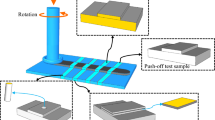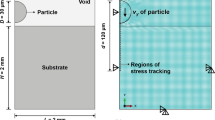Abstract
In this study, the effect of heat input in friction surfacing on coating geometry, topology, microstructure, and wear resistance was investigated using numerical and experimental methods. Numerical results were obtained from smoothed-particle hydrodynamics and finite element models, which were calibrated using experimental data. The results demonstrate that the smoothed-particle hydrodynamics model accurately simulates the maximum temperature, heating slope, and the cooling rate during friction surfacing, in comparison to the finite element model. The maximum error in estimating thermal profile parameters in the smoothed-particle hydrodynamics model is 6%, while in the finite element model, it is 11%. Additionally, unlike the finite element model, the smoothed-particle hydrodynamics model can predict the coating geometry with acceptable accuracy, independently of the experimental results. The heat input in friction surfacing strongly affects the material required for the formation of an unbonded zone in the coating. The smoothed-particle hydrodynamics model can predict the surface roughness and roughness at the coating–substrate interface by maximum 8%. Coating A390 aluminum alloy with a heat input of 115 J/mm resulted in hardness and wear resistance increases as 2.47 and 1.6 times, respectively, compering to AA1050 aluminum substrate.


















Similar content being viewed by others
Data availability
The data that support the findings of this study are available from the corresponding author upon reasonable request.
References
Ma Z. Friction stir processing technology: a review. Metall Mater Trans A. 2008;39:642–58.
Pouraliakbar H, Beygi R, Fallah V, Hosseini Monazzah A, Reza Jandaghi M, Khalaj G, da Silva LFM, Pavese M. Processing of Al-Cu-Mg alloy by FSSP: parametric analysis and the effect of cooling environment on microstructure evolution. Mater Lett. 2022;308:131157.
Jandaghi MR, Saboori A, Khalaj G, Khanzadeh Ghareh Shiran M. Microstructural evolutions and its impact on the corrosion behaviour of explosively welded Al/Cu bimetal. Metals. 2020;10:634.
Sarkari Khorrami M, Mostafaei MA, Pouraliakbar H, Kokabi AH. Study on microstructure and mechanical characteristics of low-carbon steel and ferritic stainless steel joints. Mater Sci Eng A. 2014;608:35–45.
Gandra J, Krohn H, Miranda R, Vilaça P, Quintino L, dos Santos JF. Friction surfacing—a review. J Mater Process Technol. 2014;214:1062–93.
Pouraliakbar H, Khalaj G, Jandaghi MR, Fadaei A, Ghareh-Shiran MK, Shim SH, Hong SI. Three-layered SS321/AA1050/AA5083 explosive welds: effect of PWHT on the interface evolution and its mechanical strength. Int J Press Vessels Pip. 2020;188: 104216.
Rahmati Z, Jamshidi Aval H, Nourouzi S, Jamaati R. Modeling and experimental study of friction surfacing of AA2024 alloy over AA1050 plates. Mater Res Express. 2019;6:0865g2.
Pirhayati P, Jamshidi Aval H. An investigation on thermo-mechanical and microstructural issues in friction surfacing of Al–Cu aluminum alloys. Mater Res Express. 2019;6:056550.
Liu X, Yao J, Wang X, Zou Z, Qu S. Finite difference modeling on the temperature field of consumable-rod in friction surfacing. J Mater Process Technol. 2009;209:1392–9.
Zhang Y, Ren Z, Ju J, Liu Z. A coupled acoustic-thermal-fluid model and numerical simulation of ultrasound vibration assisted friction surfacing. Sci Technol Weld Join. 2020;25:135–41.
Bararpour SM, Jamshidi Aval H, Jamaati R. Modeling and experimental investigation on friction surfacing of aluminum alloys. J Alloys Compd. 2019;805:57–68.
Vitanov VI, Javaid N. Investigation of the thermal field in micro friction surfacing. Surf Coat Technol. 2010;204:2624–31.
Isupov FY, Panchenko O, Zhabrev L, Mushnikov I, Rylkov EN, Popovich AA. Finite element simulation of temperature field during friction surfacing of Al-5Mg consumable rod. Key Eng Mater. 2019;822:737–44.
Kallien Z, Klusemann B. Combined experimental-numerical analysis of the temperature evolution and distribution during friction surfacing. Surf Coat Technol. 2022;437:128350.
Jamshidi Aval H. Comprehensive thermo-mechanical simulation of friction surfacing of aluminum alloys using smoothed particle hydrodynamics method. Surf Coat Technol. 2021;419:127274.
George Sahaya Nixon R, Mohanty BS, Sathish R. Friction surfacing of AISI 316 over mild steel: a characteriation study. Def Technol. 2018;14:306–12.
Bararpour SM, Jamshidi Aval H, Jamaati R. Cellular automaton modeling of dynamic recrystallization in Al-Mg alloy coating fabricated using the friction surfacing process. Surf Coat Technol. 2021;407:126784.
Rahaman MM, Pathak A, Roy D. A thermo-visco-plastic damage model and SPH simulations of plugging failure. Mech Adv Mater Struct. 2018;25:1374–82.
Pirhayati P, Jamshidi Aval H. Phase-field microstructure simulation during aluminum alloy friction surfacing. Surf Coat Technol. 2020;402:126496.
Liang Z, Li W, Zhu B, Niu L. Modelling dynamic recrystallization of A356 aluminum alloy during hot deformation. Metals. 2022;12:1407.
Humphreys FJ, Hatherly M. Recrystallization and related annealing phenomena. Elsevier; 2012.
Subramanian C. 2—Wear properties of aluminium-based alloys. In: Dong H, editor. Surface engineering of light alloys. Woodhead Publishing; 2010. p. 40–57.
Liu Y, Asthana R, Rohatgi P. A map for wear mechanisms in aluminium alloys. J Mater Sci. 1991;26:99–102.
Author information
Authors and Affiliations
Corresponding author
Ethics declarations
Conflict of interest
All authors declare that they have no conflicts of interest.
Ethical statement
Authors state that the research was conducted according to ethical standards.
Additional information
Publisher's Note
Springer Nature remains neutral with regard to jurisdictional claims in published maps and institutional affiliations.
Rights and permissions
Springer Nature or its licensor (e.g. a society or other partner) holds exclusive rights to this article under a publishing agreement with the author(s) or other rightsholder(s); author self-archiving of the accepted manuscript version of this article is solely governed by the terms of such publishing agreement and applicable law.
About this article
Cite this article
Bararpour, S.M., Jamshidi Aval, H., Jamaati, R. et al. Comparison of finite element and smoothed-particle hydrodynamics models in the simulation of hypereutectic Al-Si alloy friction surfacing: calibrations from experiments. Archiv.Civ.Mech.Eng 23, 224 (2023). https://doi.org/10.1007/s43452-023-00755-y
Received:
Revised:
Accepted:
Published:
DOI: https://doi.org/10.1007/s43452-023-00755-y




